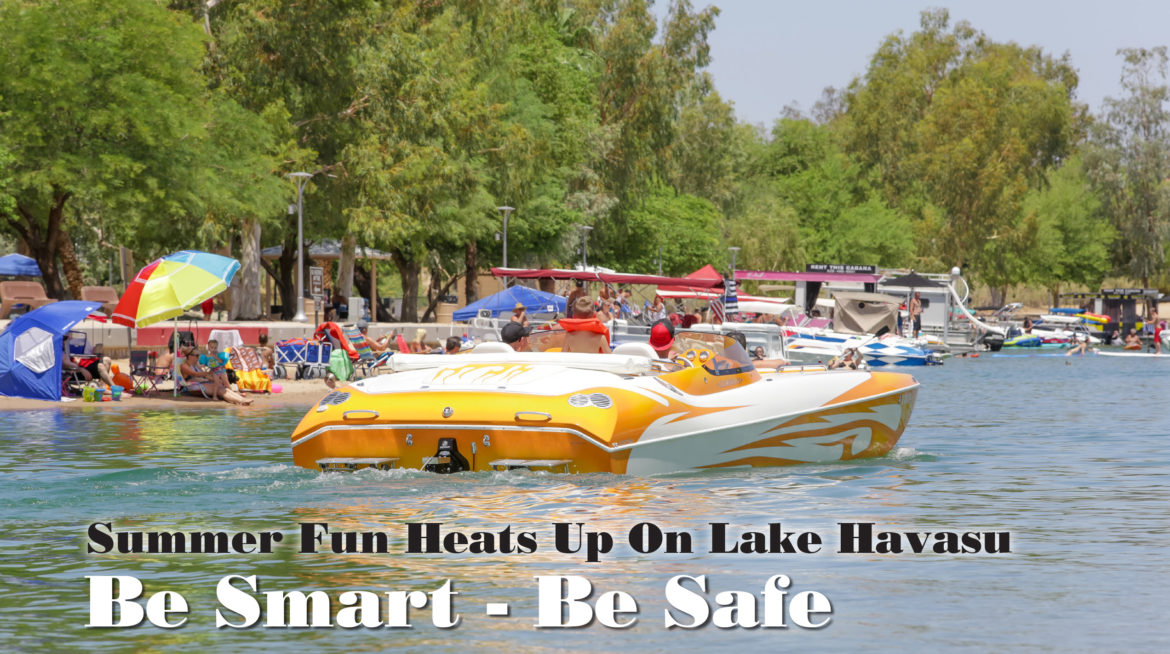Most locals will tell you that heading down to the lake to take the boat out for a spin is a no-no on
certain holiday weekends. “Just too crowded,” is the mantra that many local boaters will tell you. After all,
boaters, water-enthusiasts, and sun worshipers from across the southwest flock to Havasu on busy holiday
weekends. With Memorial Day just around the corner, and the fast-approaching Fourth of July holiday, the lake
will be a busy place.
Whether you’re from out of town or a local lake-lover, there’s plenty of room for everyone on the lake.
It just takes following some simple rules, applying common sense, and being courteous to fellow boaters for
everyone to have a great time. Of course, there are rules of the waterways to be followed much like we have to
follow the rules of the road while driving our vehicles.
Accidents happen on the water and Lake Havasu is no exception. So far this year there have been
several accidents as well as several fatalities and a number of injuries. But, overall, most people have a fun
weekend on the lake and return home without incidents. We’ve compiled a list of boating tips that may come in
handy when you head out onto the lake. Have fun, make friends, and enjoy the wonderful Havasu vibe.
Boating Safety Tips
Most boating accidents occur because drivers don’t pay attention to other watercraft on the lake. Always check
around you frequently, look behind you, and know where and when other boaters are approaching you. Never
make an abrupt turn without checking that you can do so without putting another boater at risk.
Watercraft and Personal Water Craft (PEC) don’t have brakes. When facing a potential collision, a watercraft
operator can only rely on throttle and steering to avoid a collision.
Children under 12 must wear a life vest at all times while underway on any vessel. The life vest must be fully
and properly fastened.
Every person being towed behind a vessel (either on water skis, wakeboard, tube, or other similar device) must
wear a life vest at all times while being towed.
Lake Havasu has a counter-clockwise rotation; this means you should always stay to the right of the lake. When
crossing over to the other side of the lake, always check behind you to make sure you will not be crossing
another vessel’s path.
Sailboats and non-motorized vessels always have the right-of-way.
Larger vessels (big boats) always have the right-of-way over smaller vessels (PWCs).
Vessels towing another vessel have the right-of-way over all motorized vessels.
When approaching another motorized vessel head-on, always keep to the right and “show your side”. This
means make a significant turn so the other vessel can clearly see that you are keeping to the right of them.
All motorized vessels give off carbon monoxide, a colorless, odorless, tasteless gas that is very toxic. Do not
swim near the back of the boat when the motor is running. Know the signs of carbon monoxide poisoning.
It is a federal, state, and local offense to throw garbage, plastic, debris, cigarette butts, or other trash into any
Arizona waters or shorelines. Please don’t be a litterbug! The Lake Havasu Marine Association has placed trash
bags around the lake and along the shorelines that are free to grab. Please, “pack it in, pack it out”.
Legally Required Equipment (per Federal, state, and local laws)
All watercraft vessels are legally required to carry or have certain equipment installed on their vessel. The list
below pertains to most watercraft on Lake Havasu.
Boating-safety-life-jackets-Wearable Personal Flotation Devices (Life Vests): Coast Guard-approved, Type I,
II, III or V, and one for each occupant on board.
Throwable Personal Flotation Device: At least one Coast Guard-approved, Type IV (this would include a
cushion or ring buoy.
Fire Extinguisher: All watercraft under 26′ and using any volatile liquid (gas, diesel, etc.) shall have on board a
Coast Guard-approved Type B-1 fire extinguisher in a condition available for immediate and effective use.
Vessels 26′ to less than 40′ in length must have two Coast Guard-approved Type B-1 fire extinguishers.
Navigation Lights: From sunset to sunrise, all watercraft shall display navigation lights – bright white on the aft
(top) and a combination light at the bow (front) of the boat, green to starboard (right) and red to port (left).
Flame Arrestor: All watercraft using gasoline as fuel, except outboard motors, shall attach to the carburetor a
backfire flame arrestor approved for marine use and suitably secured to the air intake.
Blower: All watercraft, except open boats, using gasoline or other flammable fuel, shall have a blower (fan) to
evacuate any explosive or flammable gases from the engine compartment.
Watercraft must have mufflers to prevent excessive or unusual noise.
Sound-Producing Device (horn): Federal law requires vessels operating on federally-controlled waters (such as
the Colorado River and lake system) be equipped with sound producing devices.
Visual Distress Signals (VDS): Vessels on federally-controlled waters (such as the Colorado River and lake
system) must be equipped with Coast Guard-approved VDS equipment, readily accessible and in good working
order. All vessels, regardless of length or type, are required to carry night signals when operating between
sunset to sunrise (this would include flares or smoke signal devices).


